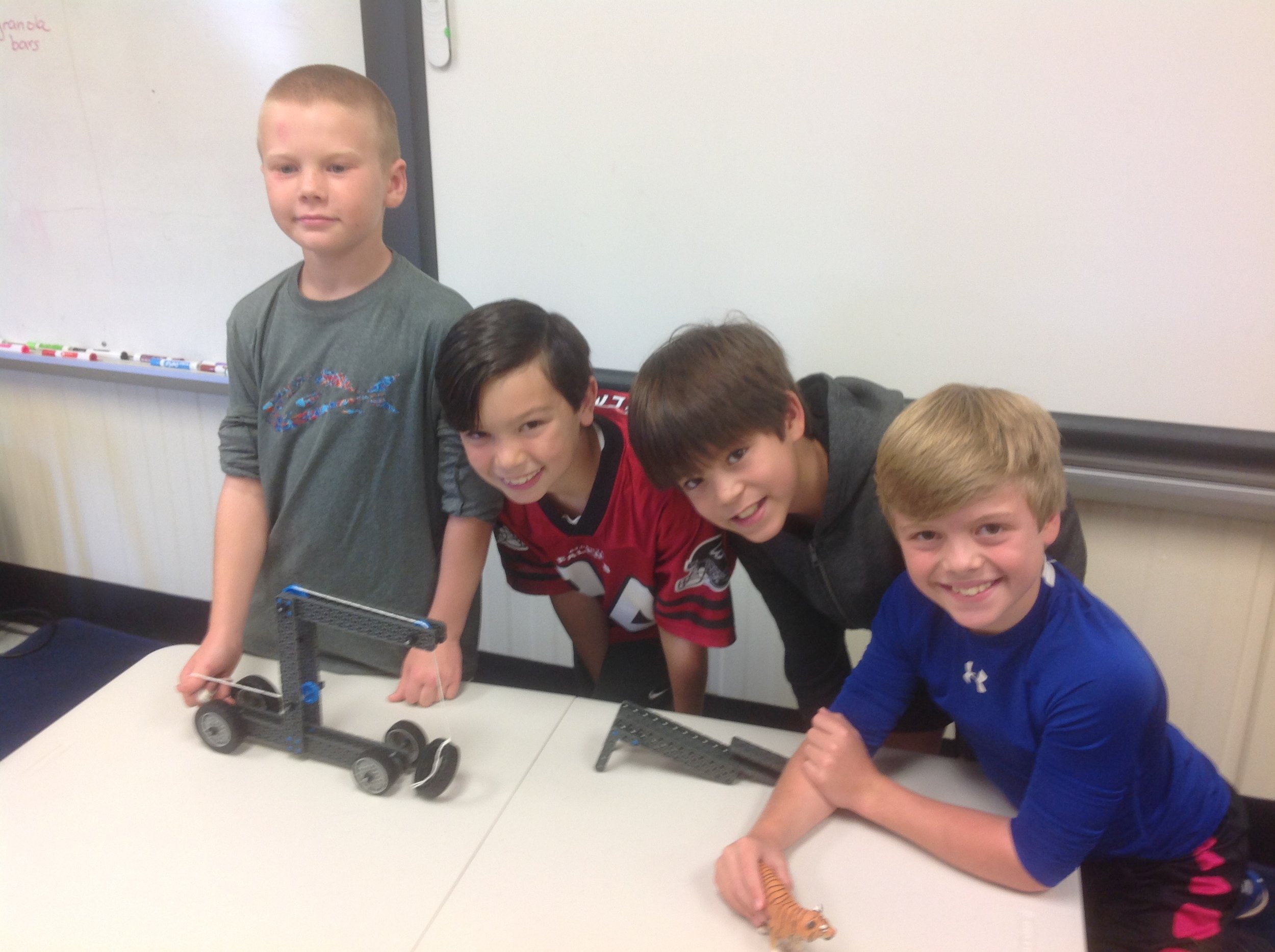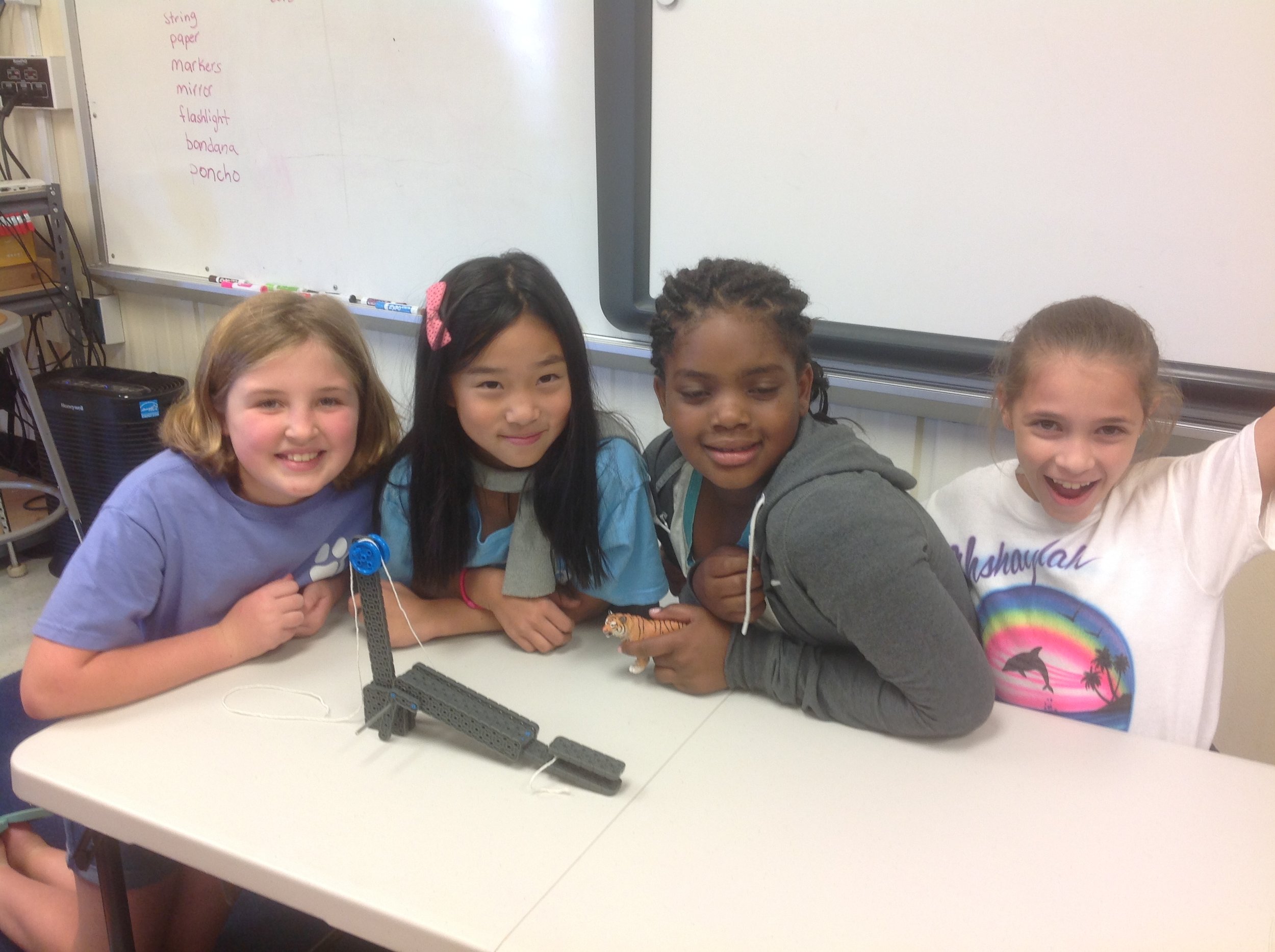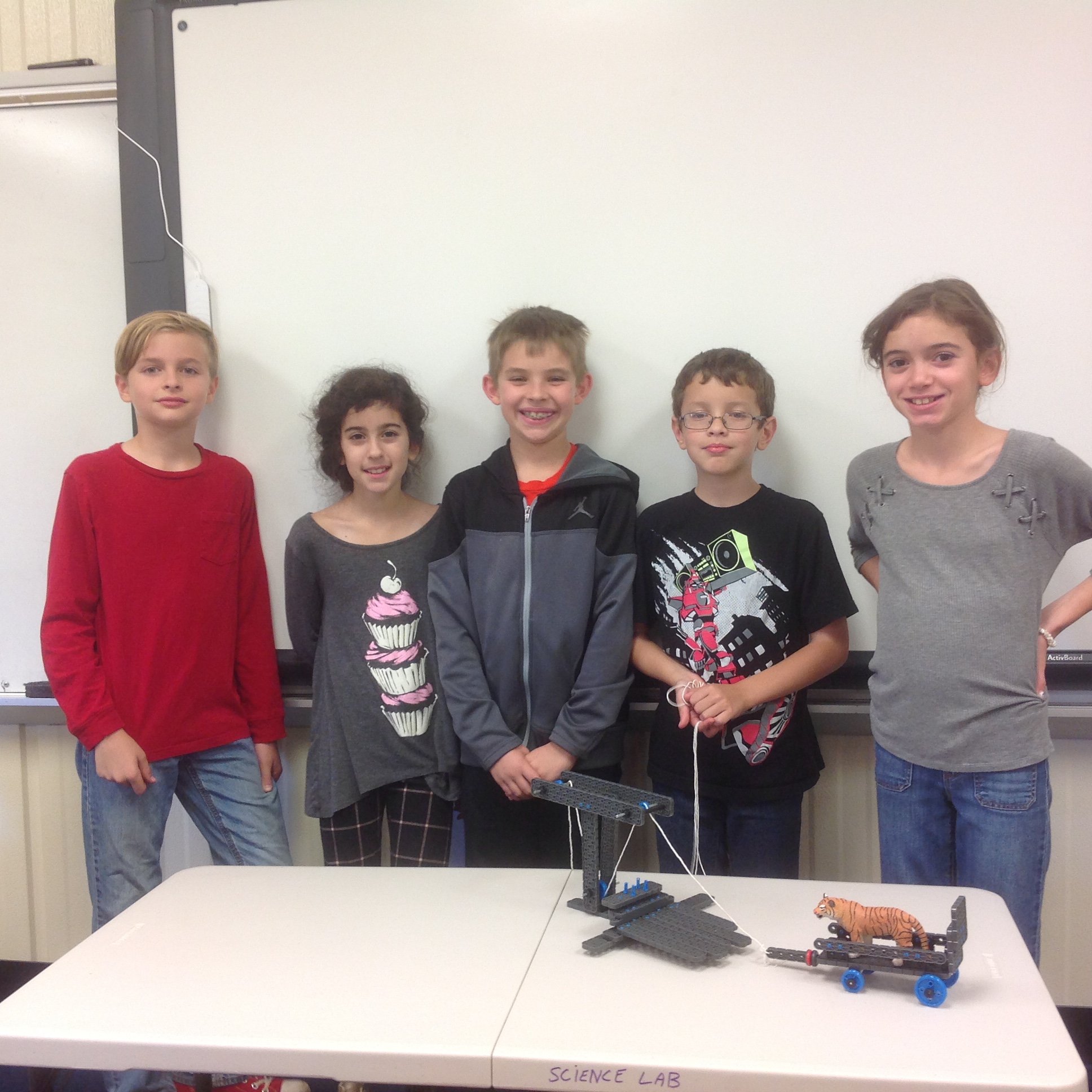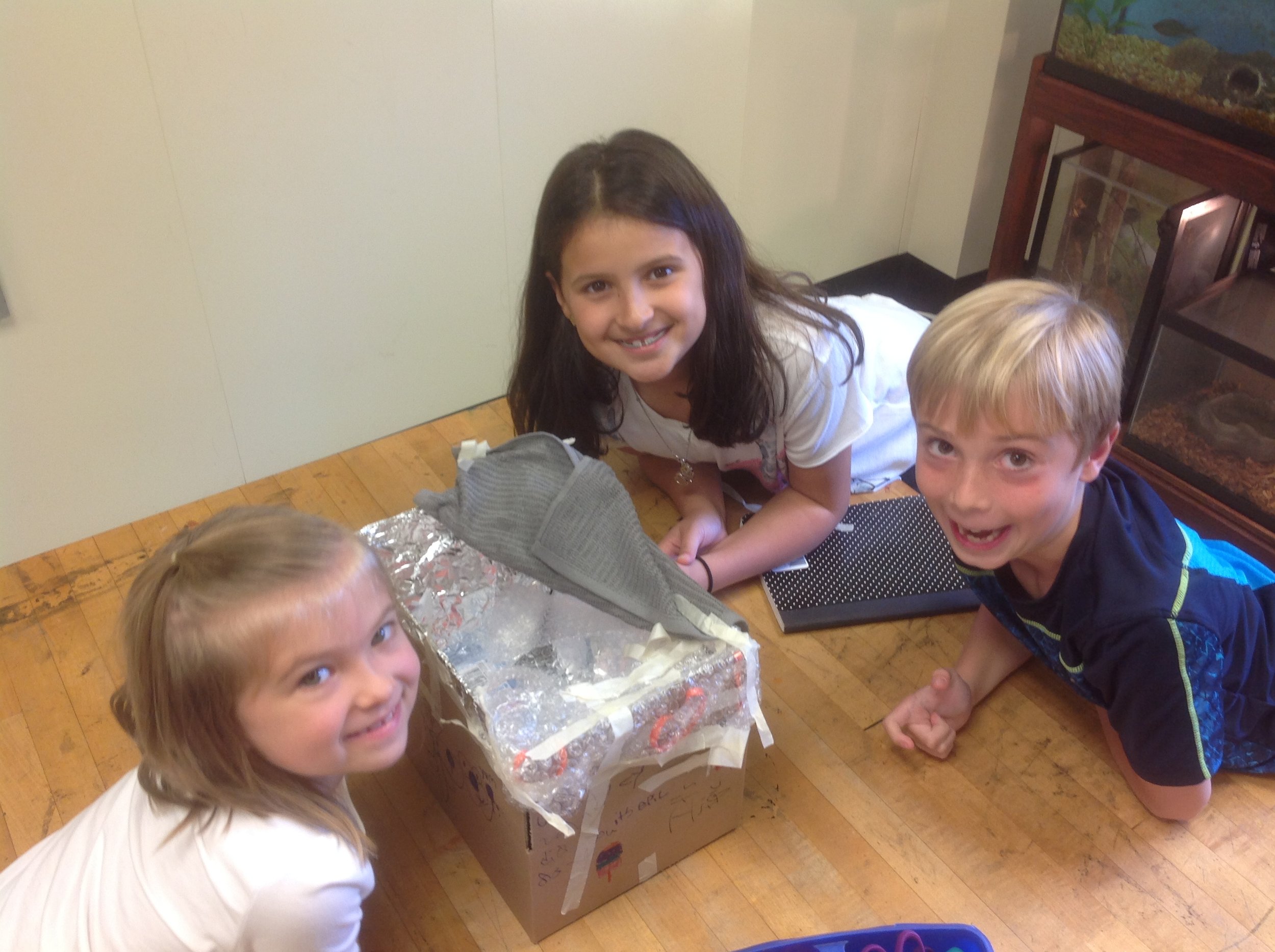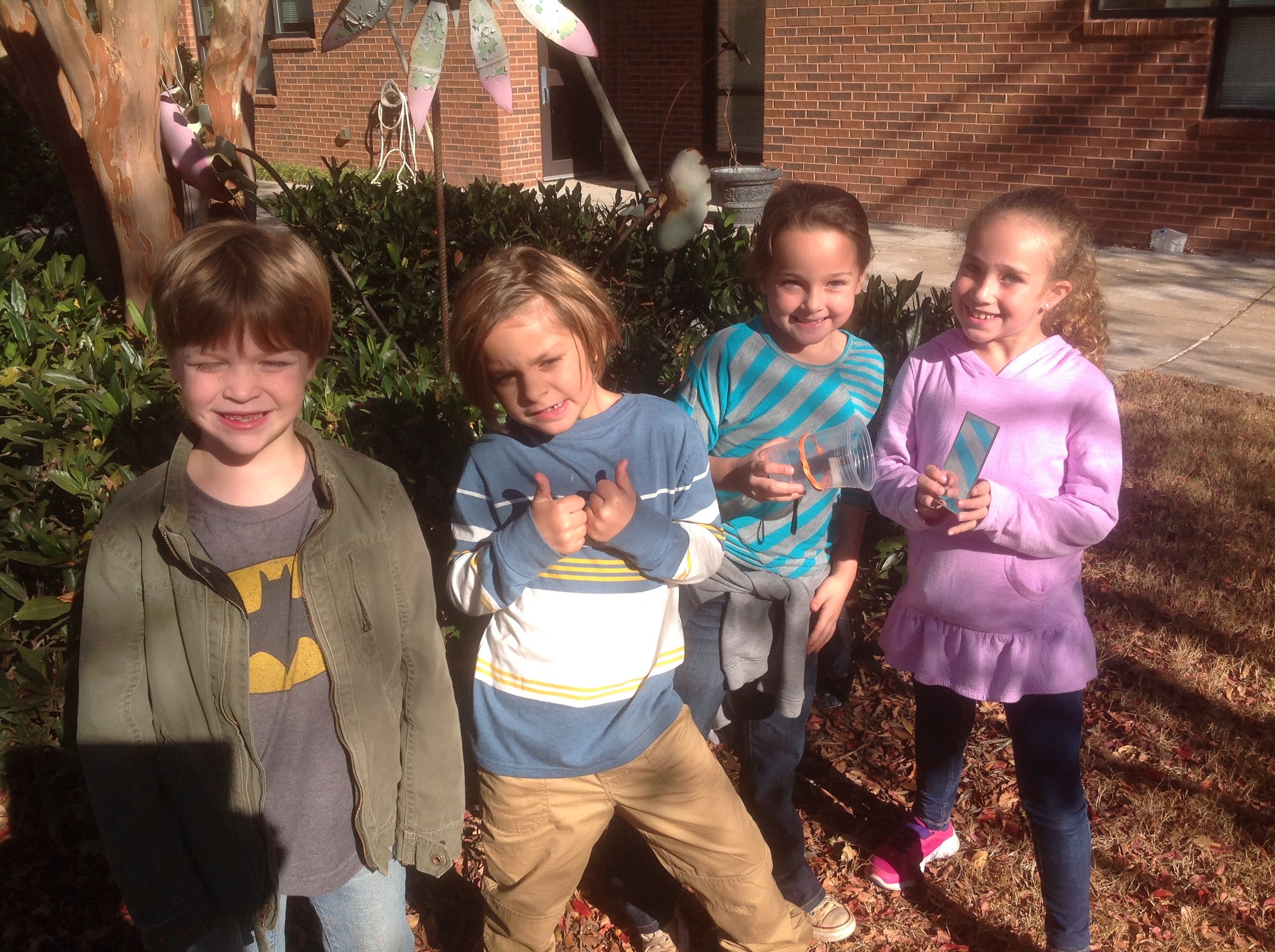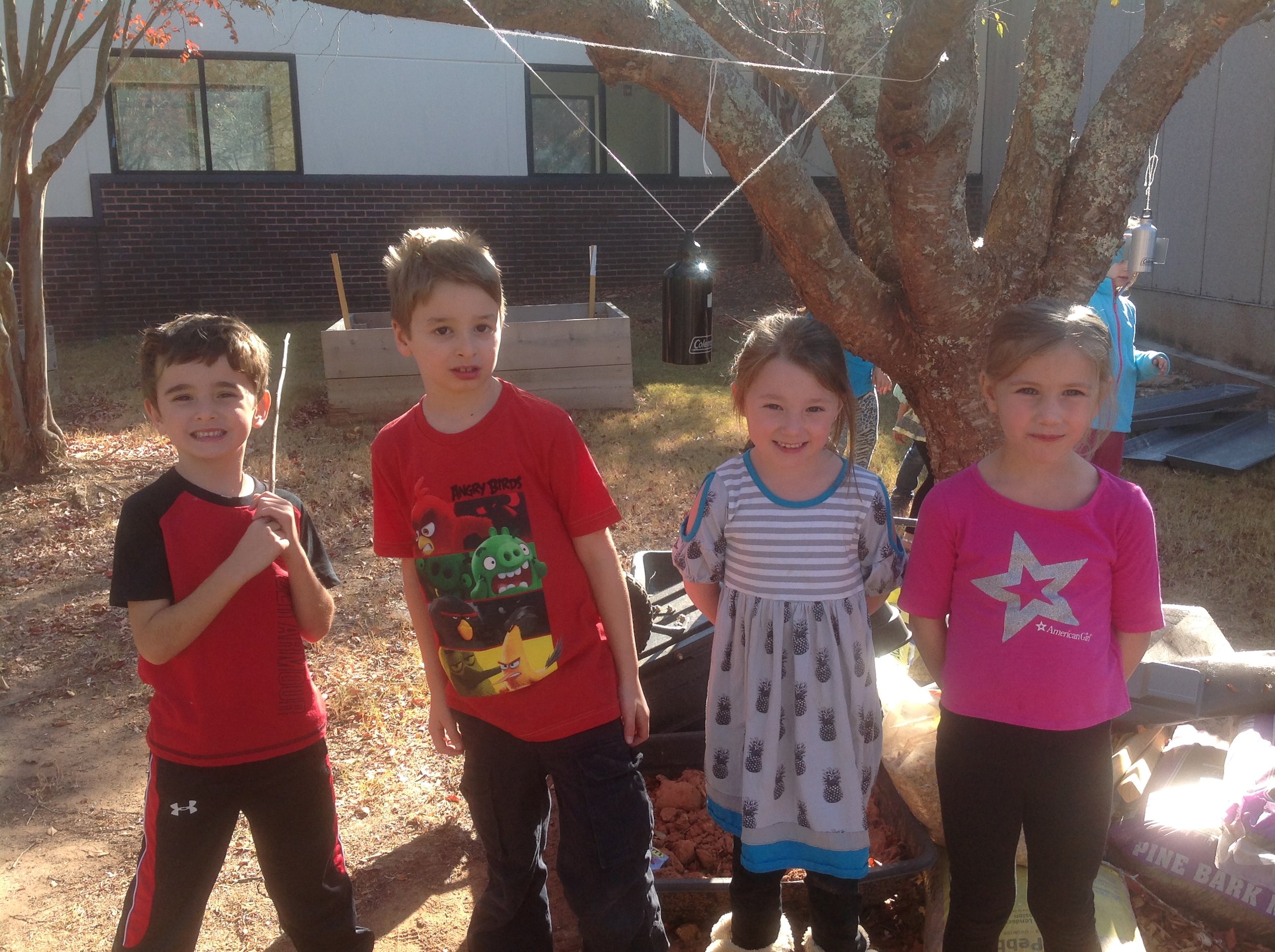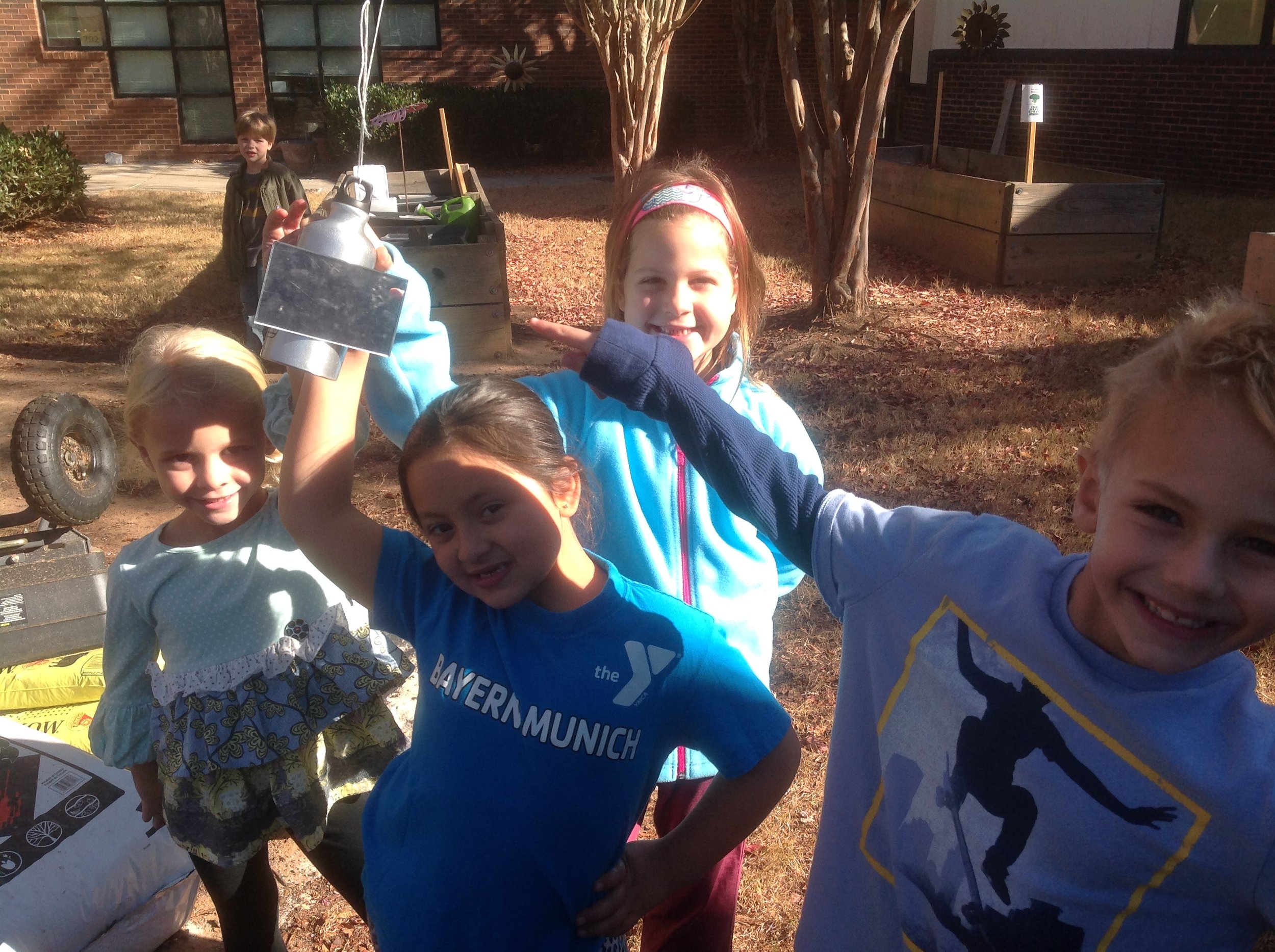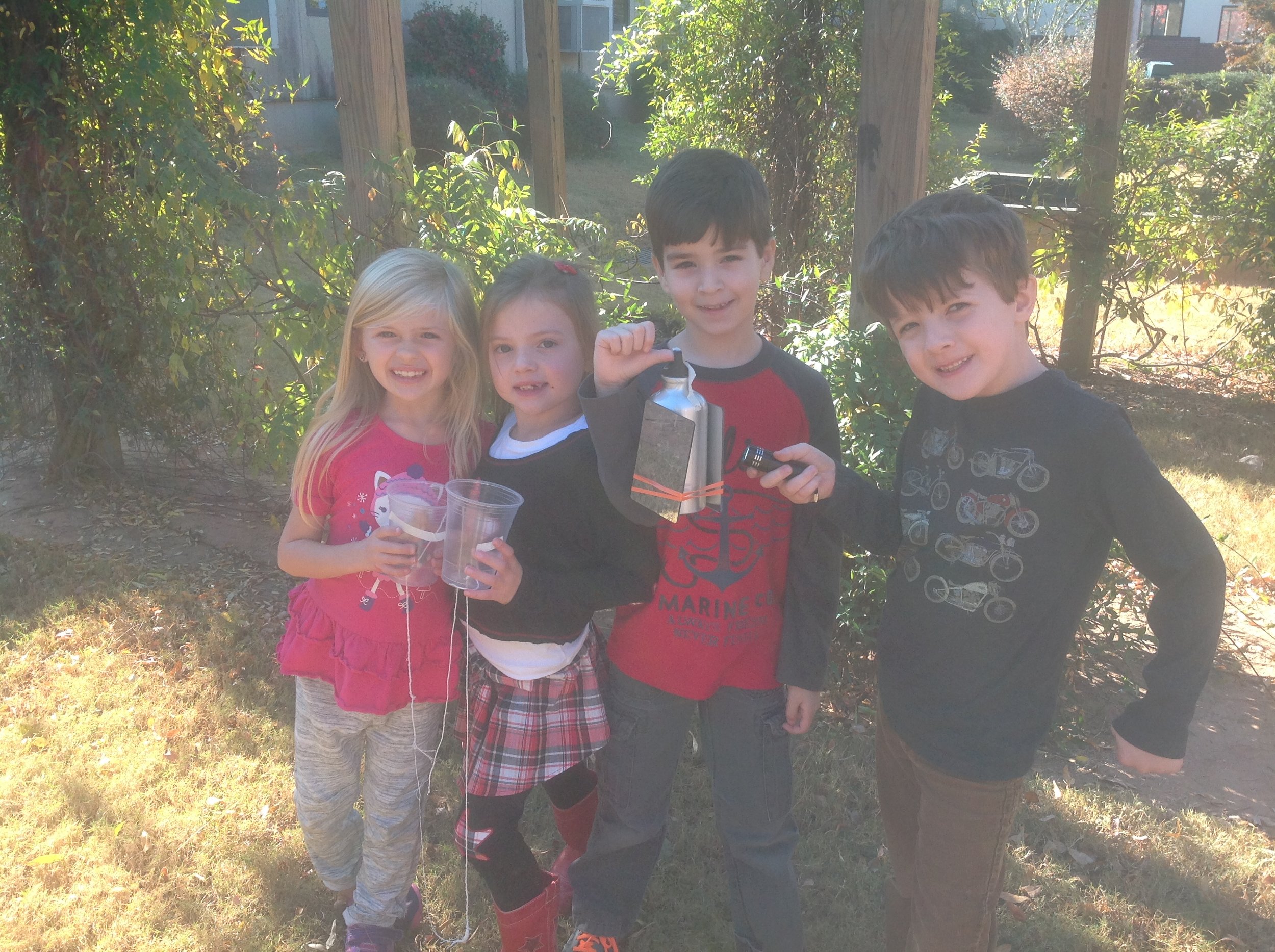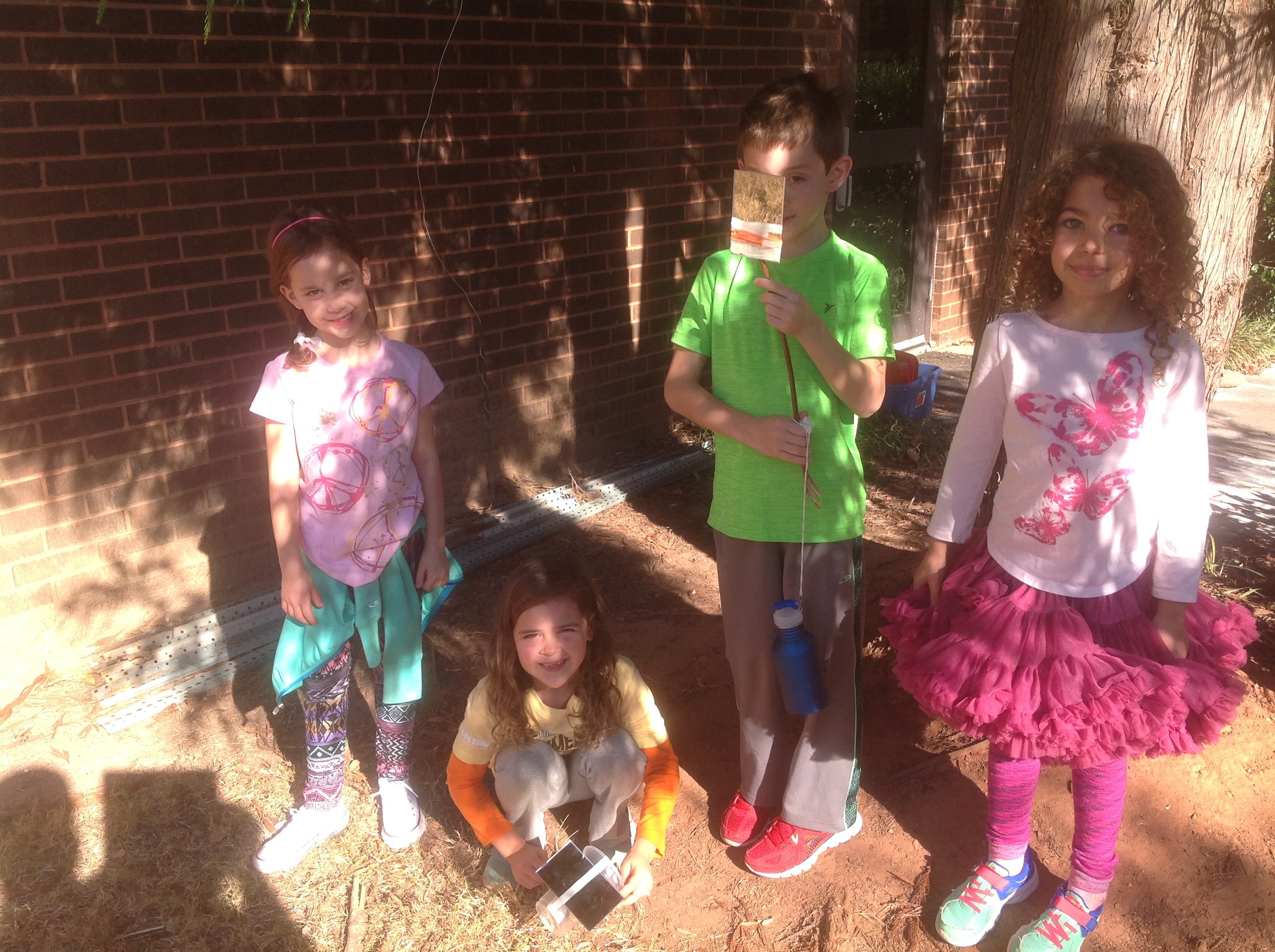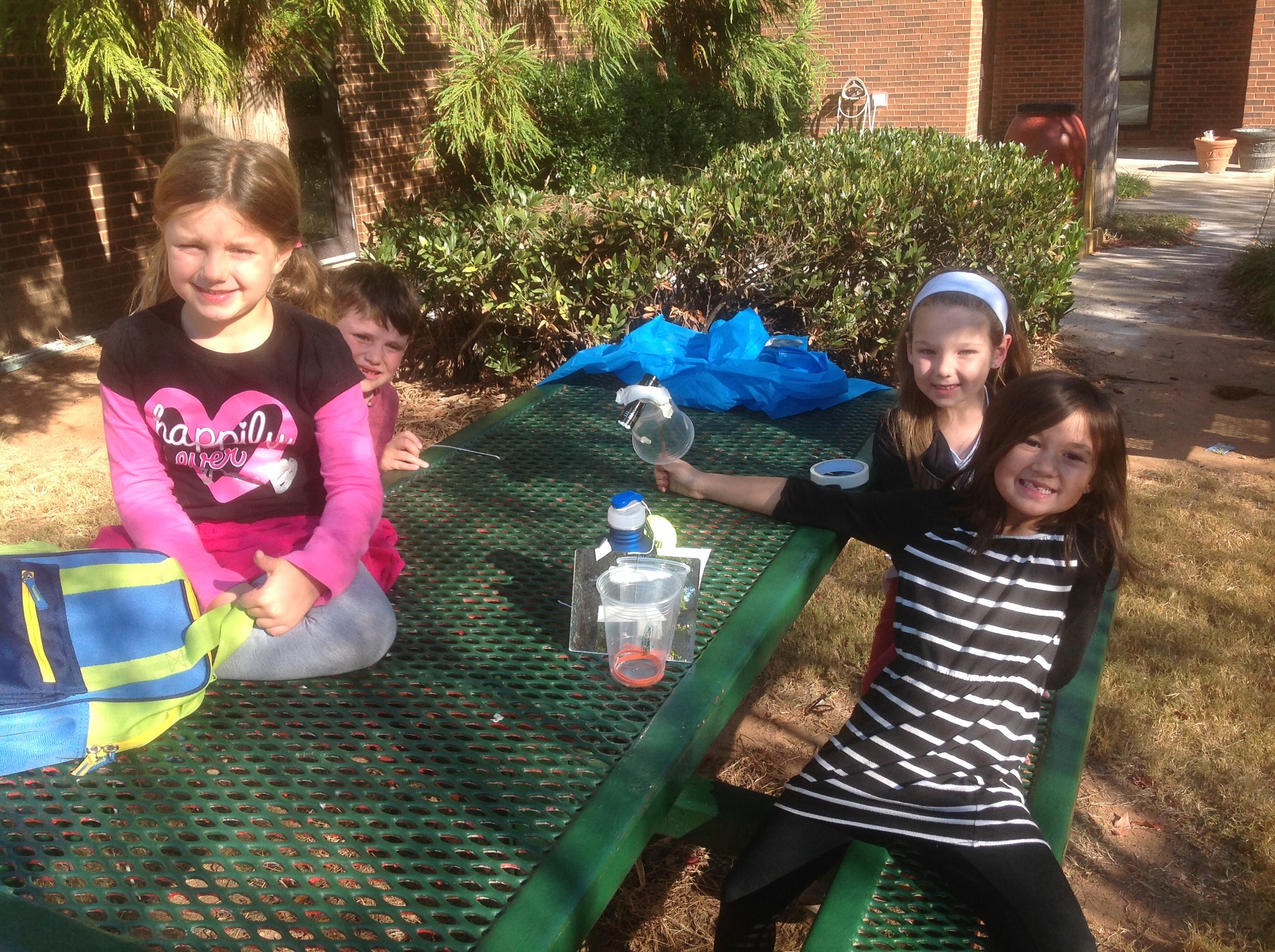Our fourth graders explored simple machines such as wheel and axles, levers, the inclined plane, and pulleys. They investigated the effects of balanced and unbalanced forces on the motion of an object. Angelina, Mylo, and Suzi go on a field trip to the zoo and are faced with the design problem of how to rescue a trapped tiger. Using our VEX kits students then applied their knowledge of forces to devise a way to rescue a heavy zoo animal while keeping it safe throughout the process.
Mrs. Wender's Class is Grrrreat!
Our fourth graders explored simple machines such as wheel and axles, levers, the inclined plane, and pulleys. They investigated the effects of balanced and unbalanced forces on the motion of an object. Angelina, Mylo, and Suzi go on a field trip to the zoo and are faced with the design problem of how to rescue a trapped tiger. Using our VEX kits students then applied their knowledge of forces to devise a way to rescue a heavy zoo animal while keeping it safe throughout the process.






Ms. Miller's Class is Grrrreat!
Our fourth graders explored simple machines such as wheel and axles, levers, the inclined plane, and pulleys. They investigated the effects of balanced and unbalanced forces on the motion of an object. Angelina, Mylo, and Suzi go on a field trip to the zoo and are faced with the design problem of how to rescue a trapped tiger. Using our VEX kits students then applied their knowledge of forces to devise a way to rescue a heavy zoo animal while keeping it safe throughout the process.
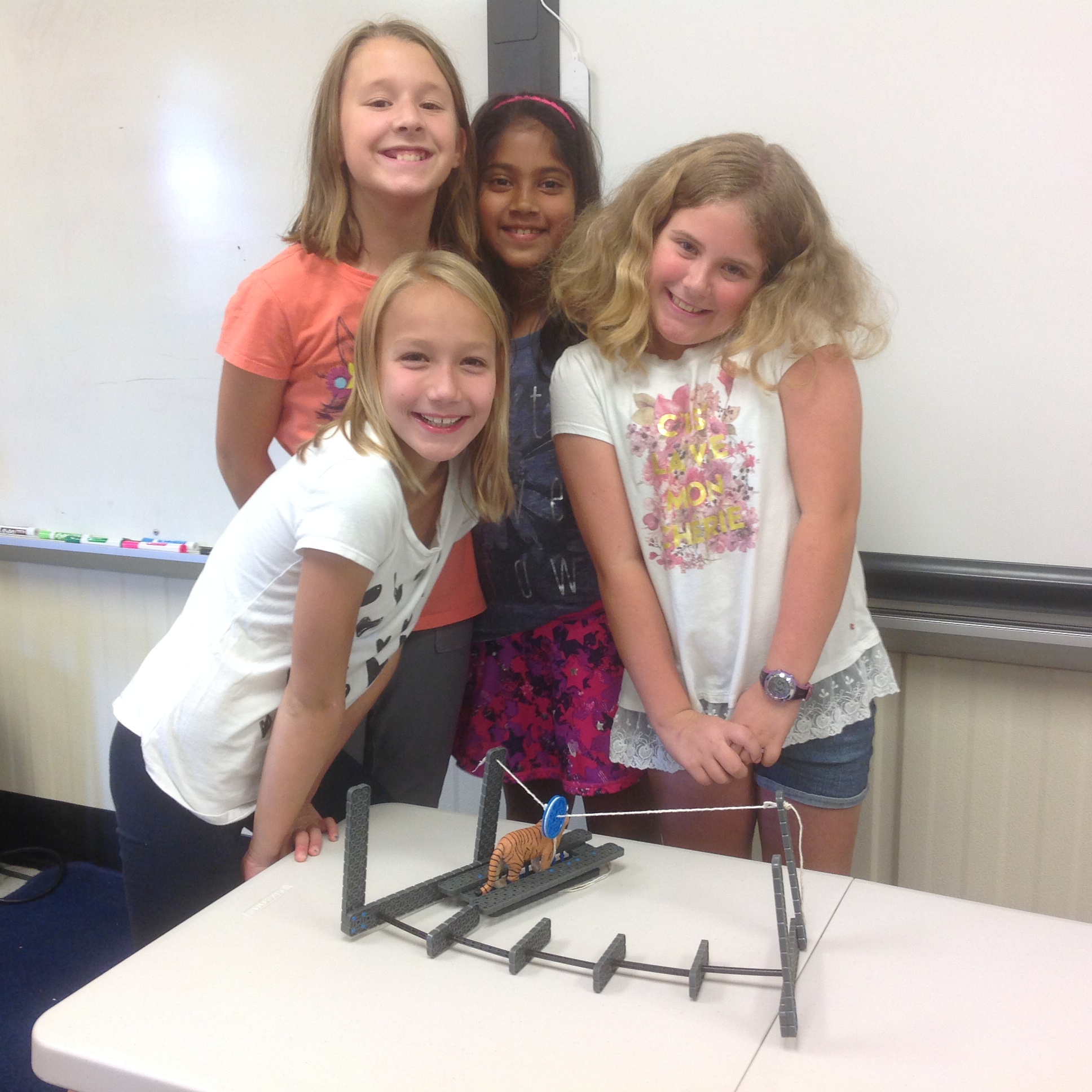
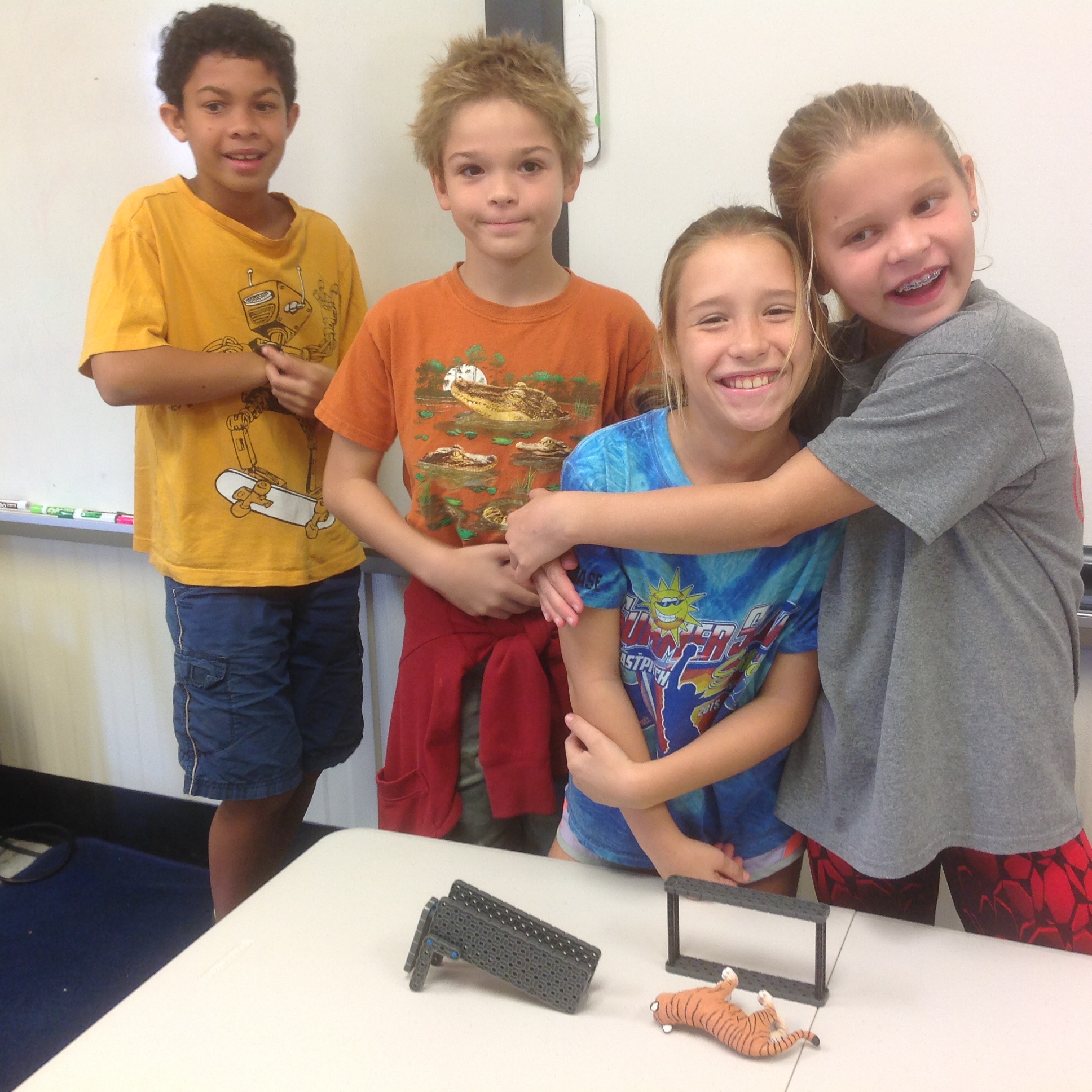
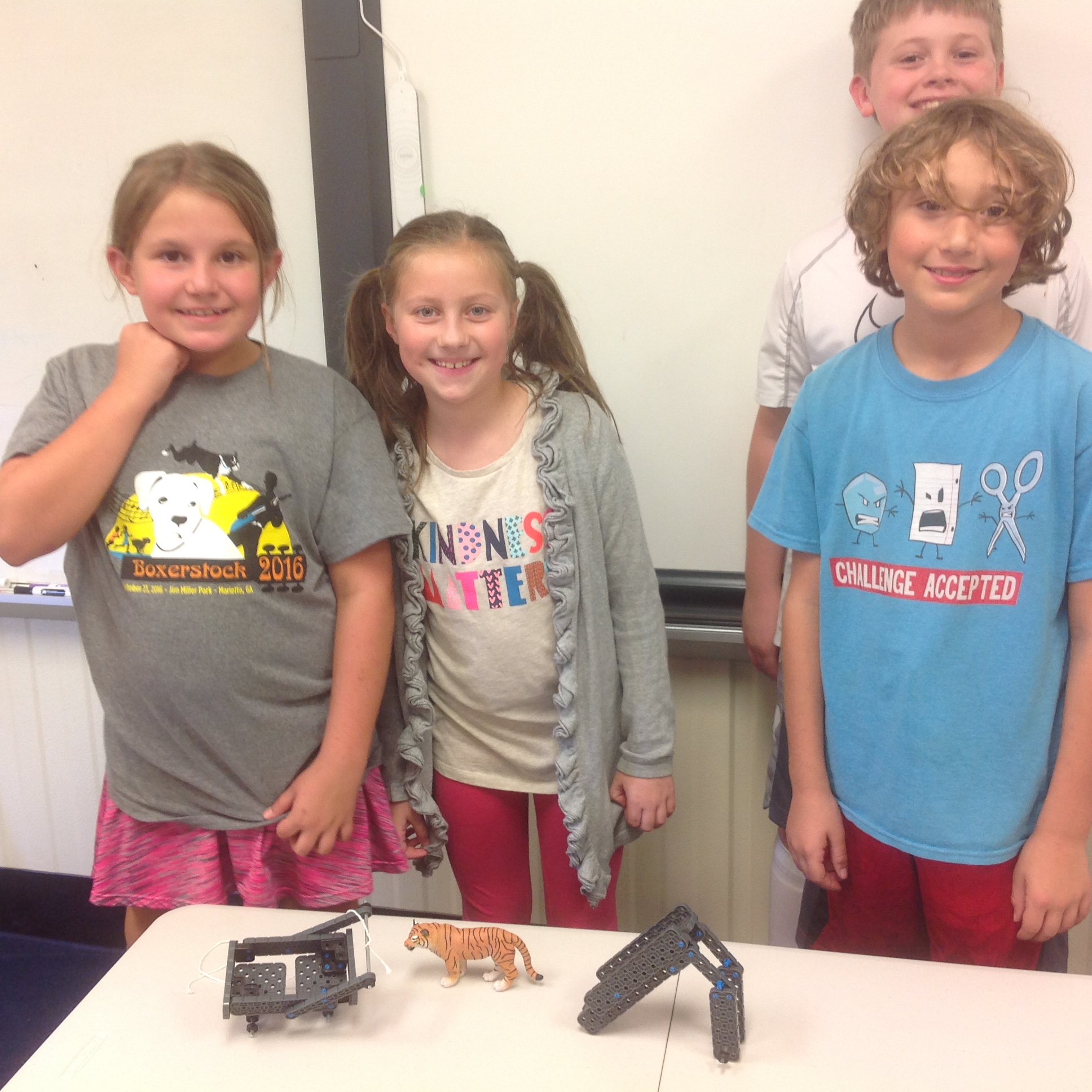
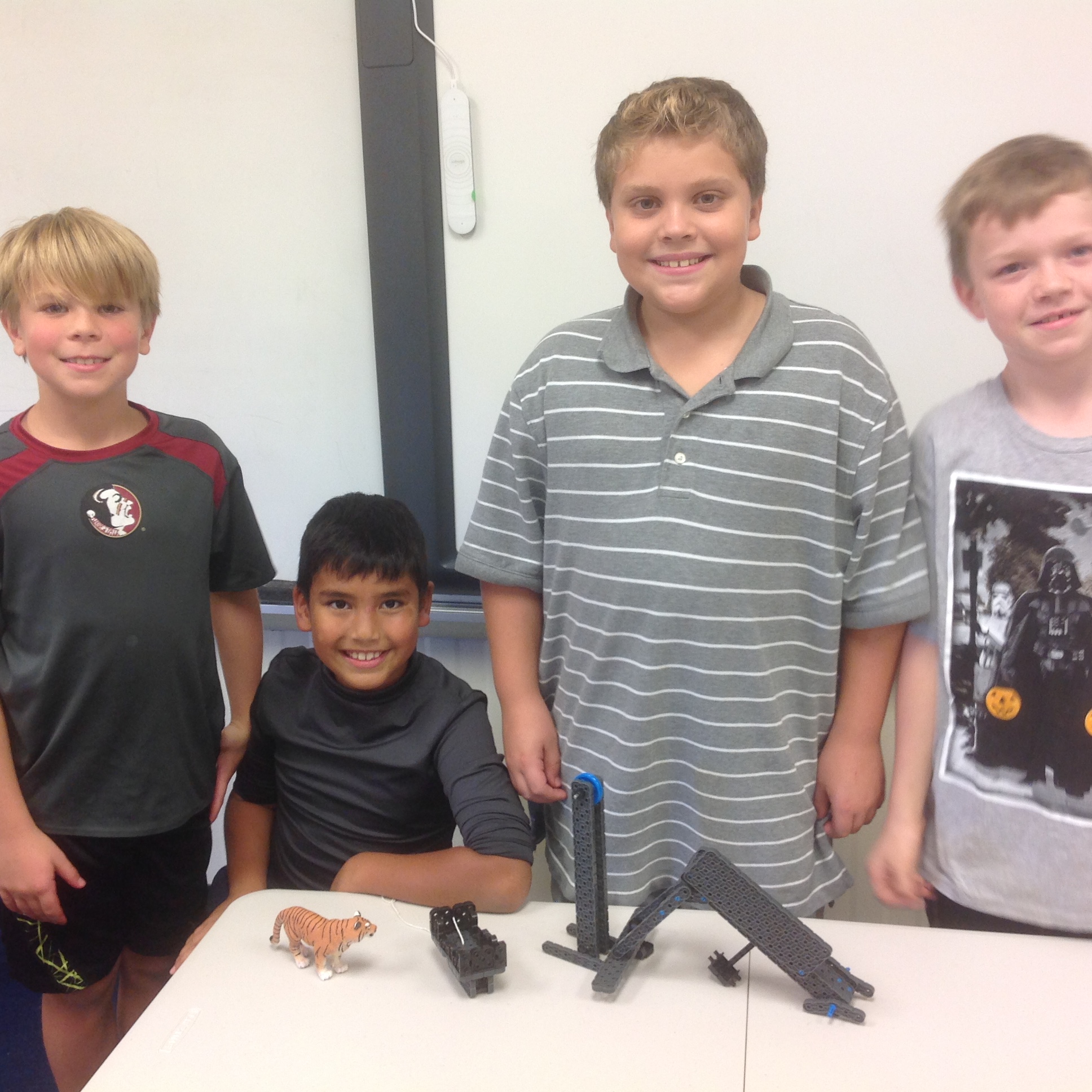
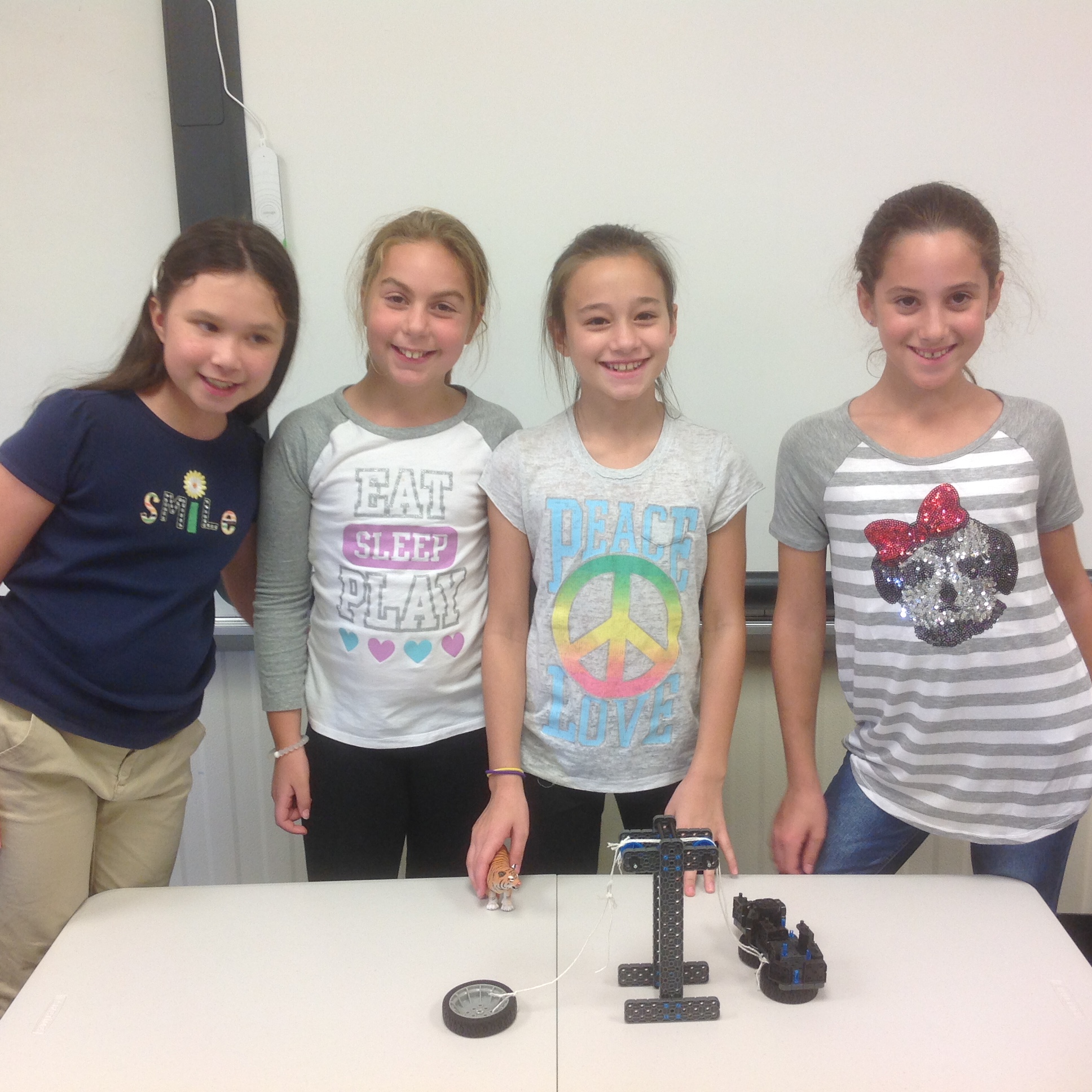
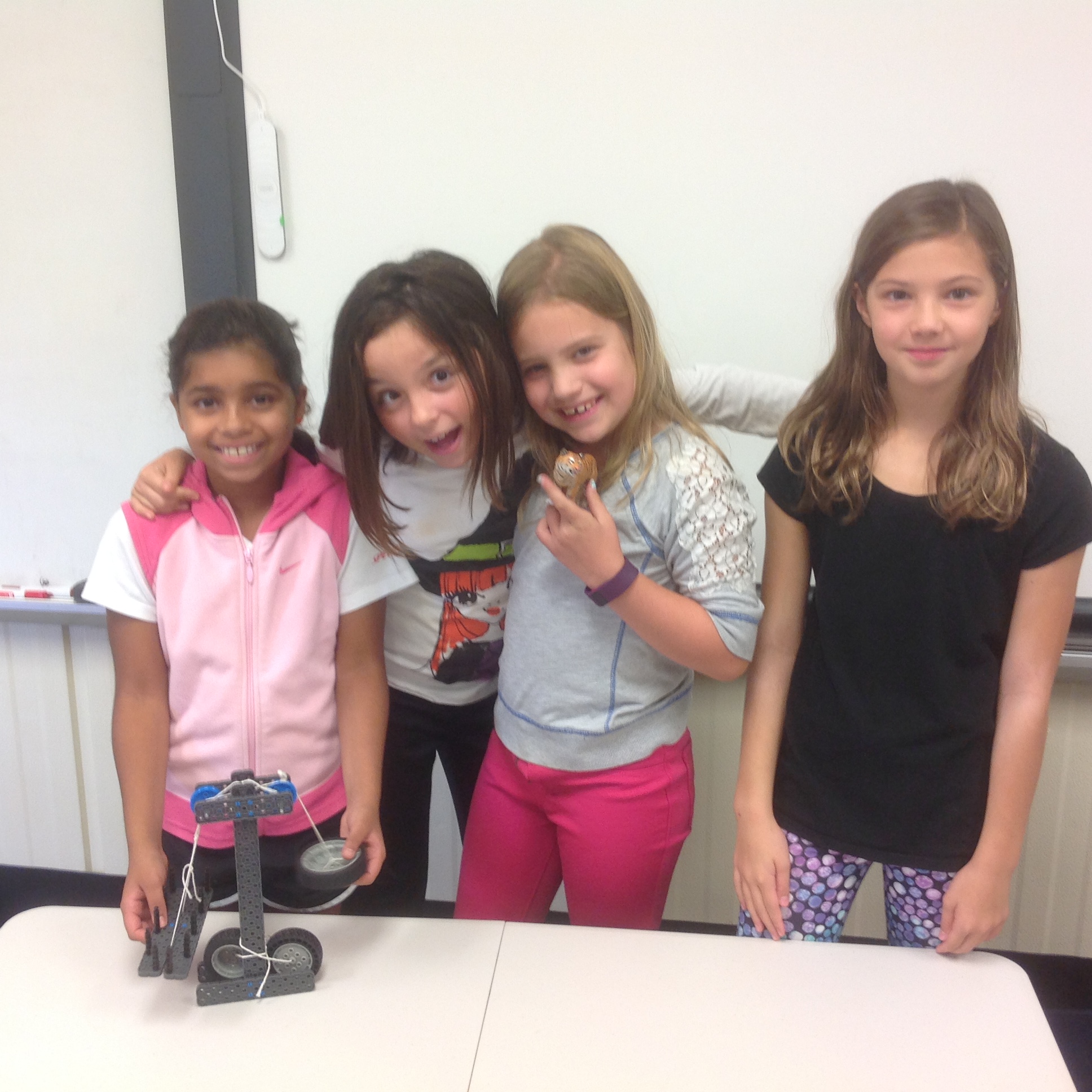
Mrs. Swift's Class is Grrrreat!
Our fourth graders explored simple machines such as wheel and axles, levers, the inclined plane, and pulleys. They investigated the effects of balanced and unbalanced forces on the motion of an object. Angelina, Mylo, and Suzi go on a field trip to the zoo and are faced with the design problem of how to rescue a trapped tiger. Using our VEX kits students then applied their knowledge of forces to devise a way to rescue a heavy zoo animal while keeping it safe throughout the process.
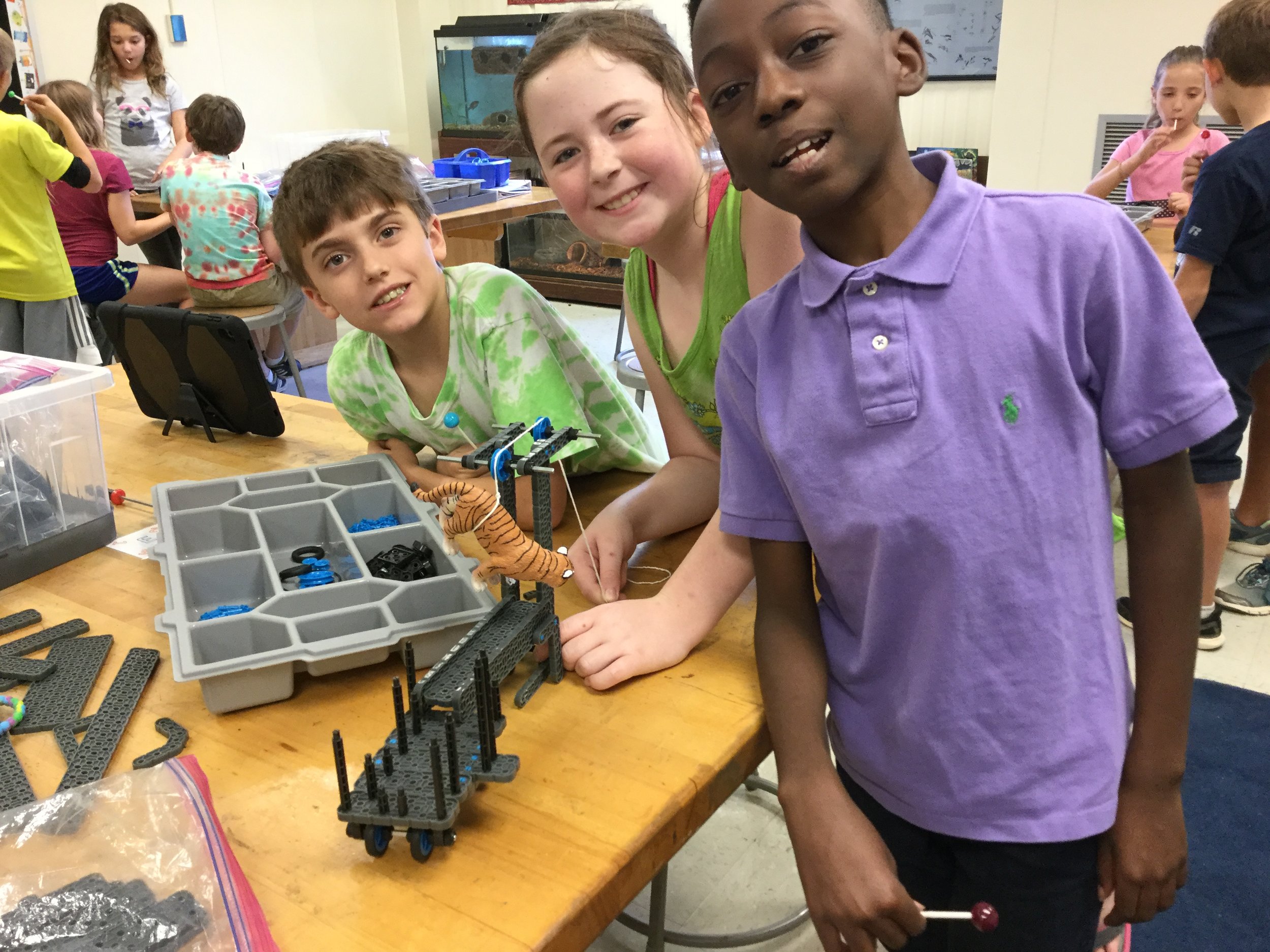
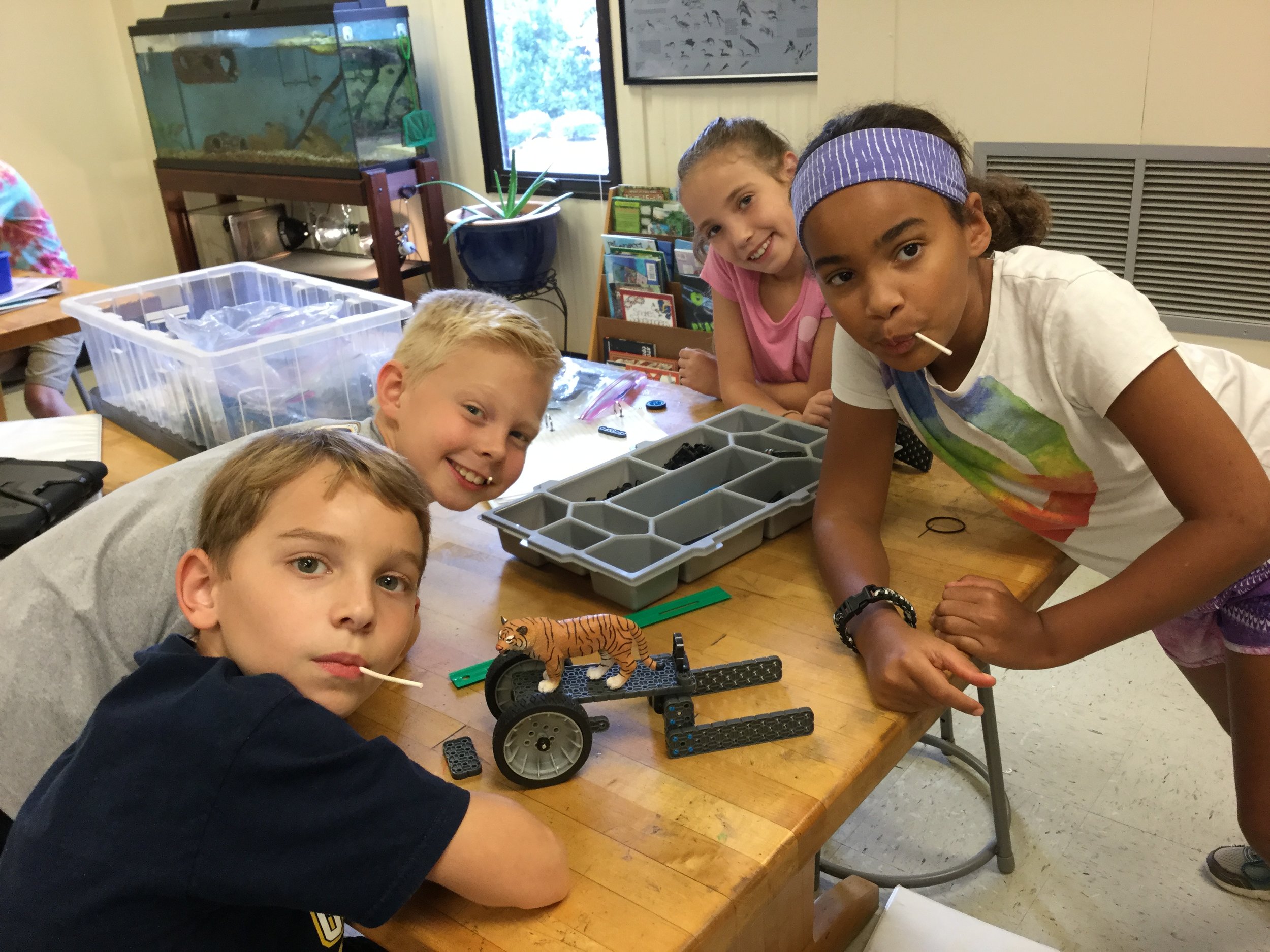

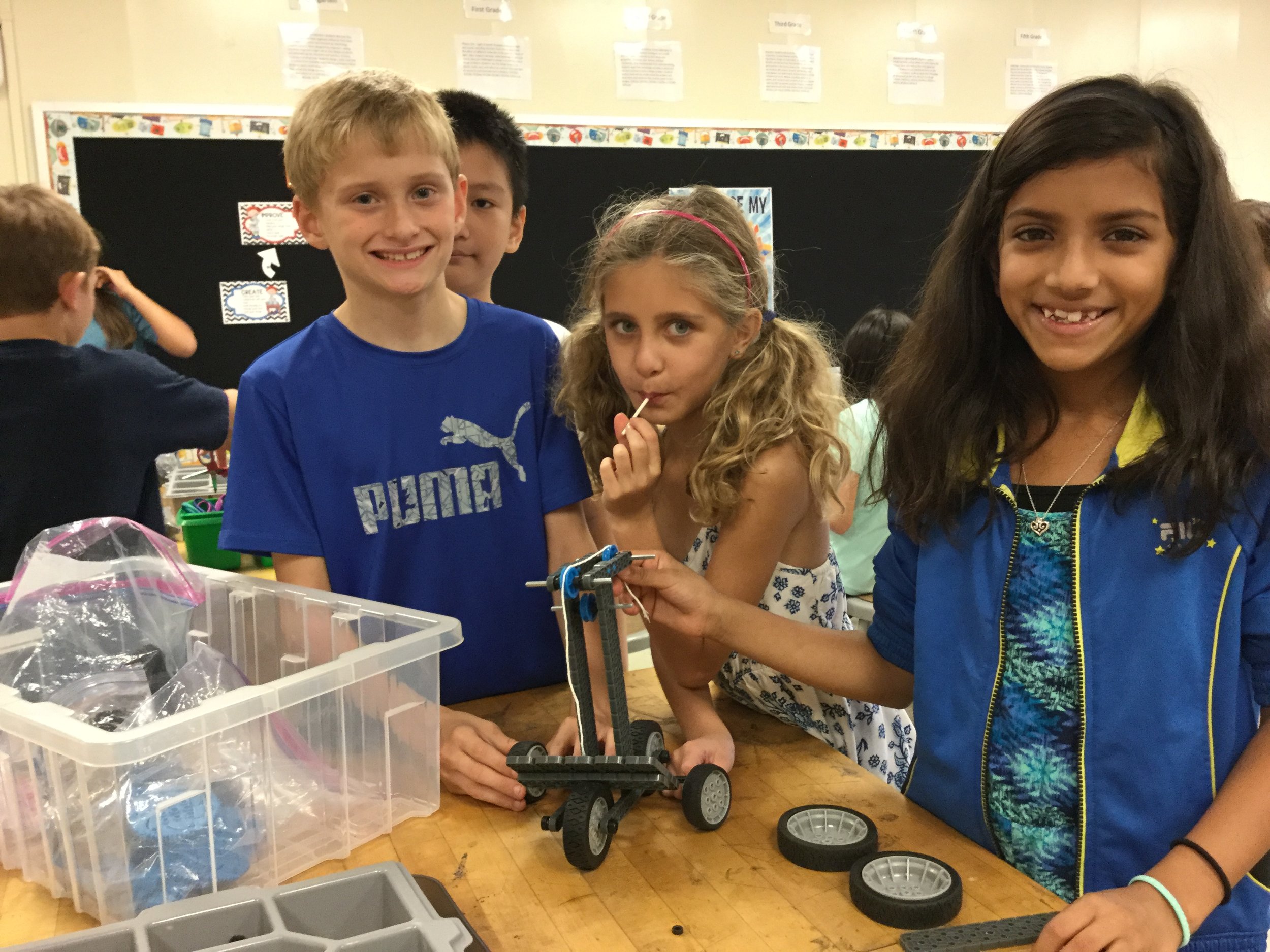
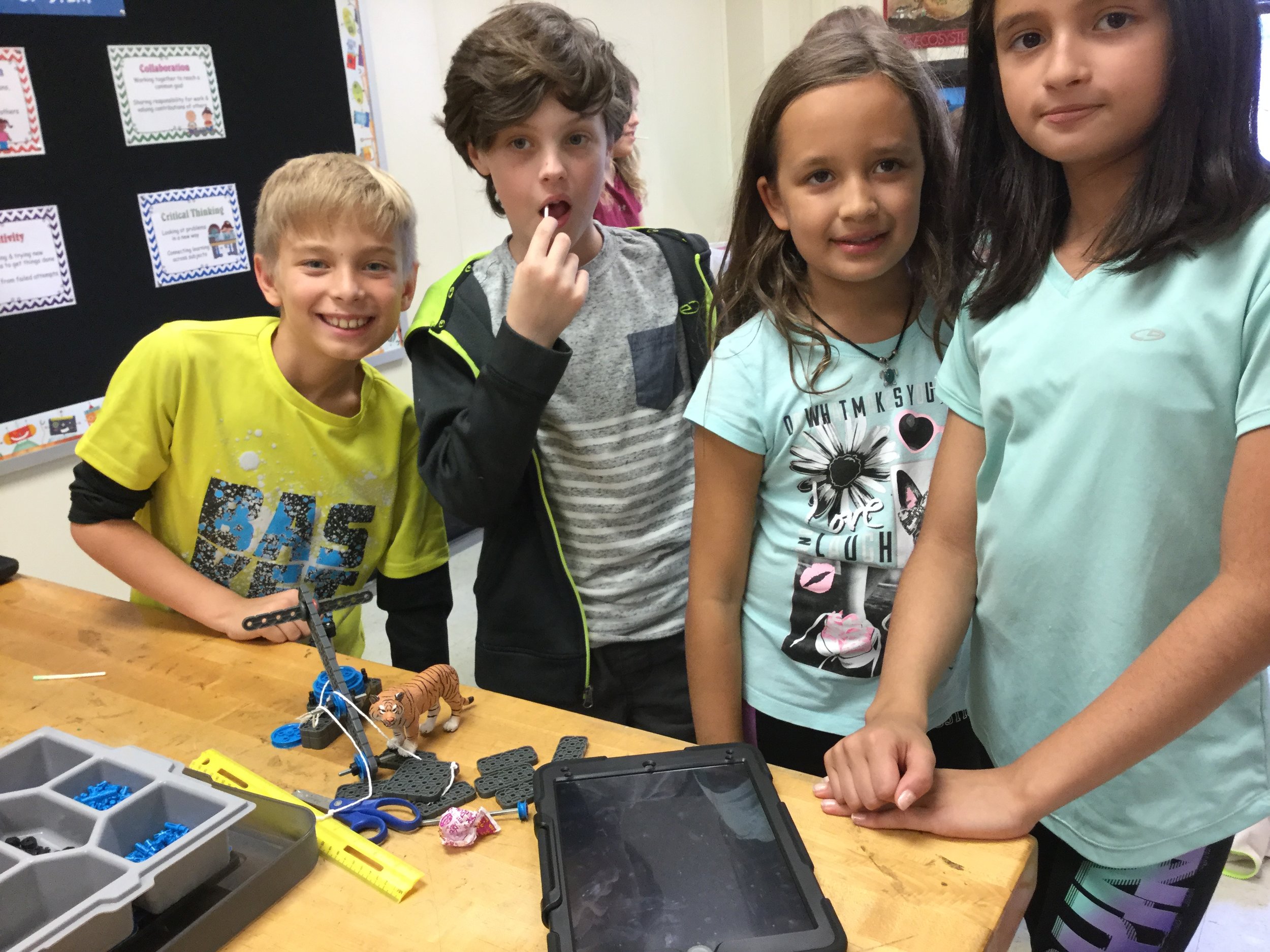
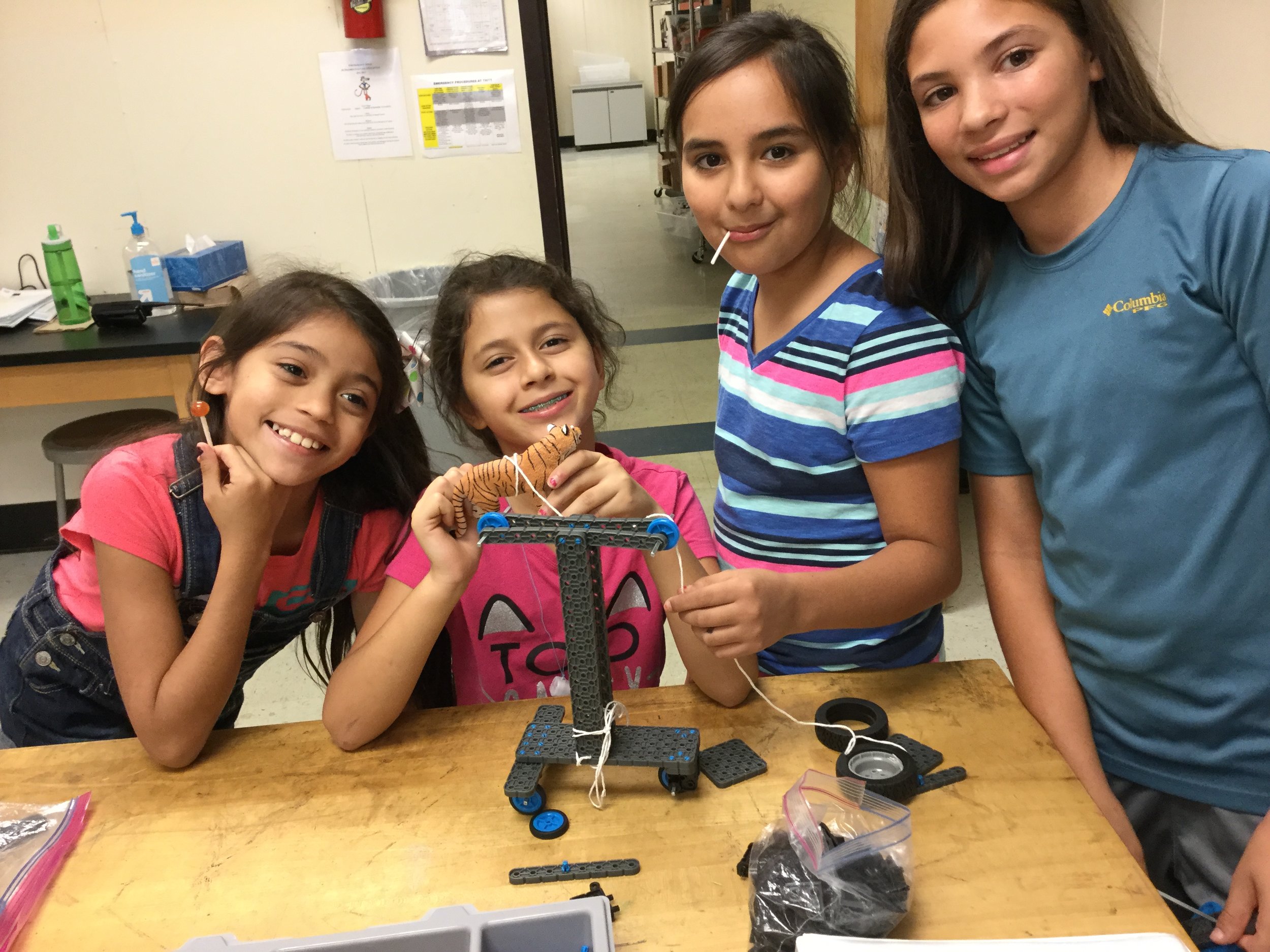
Mr. Eichler's Class is Grrrreat!
Our fourth graders explored simple machines such as wheel and axles, levers, the inclined plane, and pulleys. They investigated the effects of balanced and unbalanced forces on the motion of an object. Angelina, Mylo, and Suzi go on a field trip to the zoo and are faced with the design problem of how to rescue a trapped tiger. Using our VEX kits students then applied their knowledge of forces to devise a way to rescue a heavy zoo animal while keeping it safe throughout the process.
Mrs. Blick's Class is Grrrreat!
Our fourth graders explored simple machines such as wheel and axles, levers, the inclined plane, and pulleys. They investigated the effects of balanced and unbalanced forces on the motion of an object. Angelina, Mylo, and Suzi go on a field trip to the zoo and are faced with the design problem of how to rescue a trapped tiger. Using our VEX kits students then applied their knowledge of forces to devise a way to rescue a heavy zoo animal while keeping it safe throughout the process.






Keeping Cool with Mrs. Woolley's Class
Our students investigated and classified different kinds of materials by their observable properties, including color and texture. They learned about states of matter and properties of materials including insulators and conductors through an experiment using hand warmers and thermometers. In the design problem, Angelina, Mylo, and Suzi, are challenged to keep ice pops cold during a soccer game – without a cooler. We applied our knowledge and skills to determine the best material to solve this design problem.






Keeping Cool with Mrs. Teuchert's Class
Our students investigated and classified different kinds of materials by their observable properties, including color and texture. They learned about states of matter and properties of materials including insulators and conductors through an experiment using hand warmers and thermometers. In the design problem, Angelina, Mylo, and Suzi, are challenged to keep ice pops cold during a soccer game – without a cooler. We applied our knowledge and skills to determine the best material to solve this design problem.





Keeping Cool with Mrs. Gentry's Class
Our students investigated and classified different kinds of materials by their observable properties, including color and texture. They learned about states of matter and properties of materials including insulators and conductors through an experiment using hand warmers and thermometers. In the design problem, Angelina, Mylo, and Suzi, are challenged to keep ice pops cold during a soccer game – without a cooler. We applied our knowledge and skills to determine the best material to solve this design problem.






Keeping Cool with Ms. Gardner's Class
Our students investigated and classified different kinds of materials by their observable properties, including color and texture. They learned about states of matter and properties of materials including insulators and conductors through an experiment using hand warmers and thermometers. In the design problem, Angelina, Mylo, and Suzi, are challenged to keep ice pops cold during a soccer game – without a cooler. We applied our knowledge and skills to determine the best material to solve this design problem.






Keeping Cool with Mrs. Cervi's Class
Our students investigated and classified different kinds of materials by their observable properties, including color and texture. They learned about states of matter and properties of materials including insulators and conductors through an experiment using hand warmers and thermometers. In the design problem, Angelina, Mylo, and Suzi, are challenged to keep ice pops cold during a soccer game – without a cooler. We applied our knowledge and skills to determine the best material to solve this design problem.
Keeping Cool with Mrs. Baer's Class
Our students investigated and classified different kinds of materials by their observable properties, including color and texture. They learned about states of matter and properties of materials including insulators and conductors through an experiment using hand warmers and thermometers. In the design problem, Angelina, Mylo, and Suzi, are challenged to keep ice pops cold during a soccer game – without a cooler. We applied our knowledge and skills to determine the best material to solve this design problem.
Light & Sound - Fernandes
In first grade we have been investigating the properties of light and sound, including vibration from sound waves (we made our own cup phones!) and the effect of different materials on the path of a beam of light. After students develop an understanding of light and sound, they were challenged to solve a design problem Mylo, Suzi, and Angelina face. In the story, the characters are lost and must use only the materials in their backpack to communicate over a distance by using light and/or sound. Students use the design process to sketch, build, test, and reflect on a device that solves this design problem.
Light & Sound - Coyne
In first grade we have been investigating the properties of light and sound, including vibration from sound waves (we made our own cup phones!) and the effect of different materials on the path of a beam of light. After students develop an understanding of light and sound, they were challenged to solve a design problem Mylo, Suzi, and Angelina face. In the story, the characters are lost and must use only the materials in their backpack to communicate over a distance by using light and/or sound. Students use the design process to sketch, build, test, and reflect on a device that solves this design problem.
Light & Sound - Hughes
In first grade we have been investigating the properties of light and sound, including vibration from sound waves (we made our own cup phones!) and the effect of different materials on the path of a beam of light. After students develop an understanding of light and sound, they were challenged to solve a design problem Mylo, Suzi, and Angelina face. In the story, the characters are lost and must use only the materials in their backpack to communicate over a distance by using light and/or sound. Students use the design process to sketch, build, test, and reflect on a device that solves this design problem.
Light & Sound - Friend
In first grade we have been investigating the properties of light and sound, including vibration from sound waves (we made our own cup phones!) and the effect of different materials on the path of a beam of light. After students develop an understanding of light and sound, they were challenged to solve a design problem Mylo, Suzi, and Angelina face. In the story, the characters are lost and must use only the materials in their backpack to communicate over a distance by using light and/or sound. Students use the design process to sketch, build, test, and reflect on a device that solves this design problem.
Light & Sound - Moffett
In first grade we have been investigating the properties of light and sound, including vibration from sound waves (we made our own cup phones!) and the effect of different materials on the path of a beam of light. After students develop an understanding of light and sound, they were challenged to solve a design problem Mylo, Suzi, and Angelina face. In the story, the characters are lost and must use only the materials in their backpack to communicate over a distance by using light and/or sound. Students use the design process to sketch, build, test, and reflect on a device that solves this design problem.
Light & Sound - Adams
In first grade we have been investigating the properties of light and sound, including vibration from sound waves (we made our own cup phones!) and the effect of different materials on the path of a beam of light. After students develop an understanding of light and sound, they were challenged to solve a design problem Mylo, Suzi, and Angelina face. In the story, the characters are lost and must use only the materials in their backpack to communicate over a distance by using light and/or sound. Students use the design process to sketch, build, test, and reflect on a device that solves this design problem.
Paintbrush Test - Tommasello
Our Kindergarten students have been studying engineering, structure and function by reading different fairy tales and creating projects from them. After making towers (Jack & the Bean Stalk) and houses (The 3 Little Pigs), it all culminates in designing / creating / testing their own paintbrushes so the stories can continue at home!
Won't you be my neighbor!?
The closest star to Earth has a planet! Proxima Centauri b orbits the Centauri trinary star system. At a mere 4 1/2 light years away, the Centauri system is the closest neighbor to our own, but it would take 18,000 years to travel there in the current fastest man-made spacecraft. We are still need to learn a lot about the planet, and physicist Stephen Hawking has a plan to do just that. Called "Breakthrough Starshot", he proposes using lasers to propel a spaceship the size of a stamp to take photos of this new world. The unmanned craft would travel at 20% the speed of light and would only take 20 years to get there, plus another 4 1/2 to send back data.
Pretty cool stuff to think about. What is out there?!? Will we ever be able to see it up close?!?

